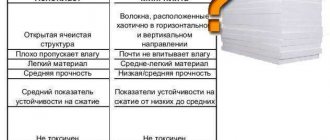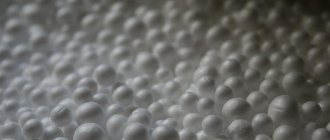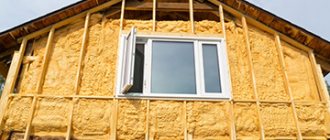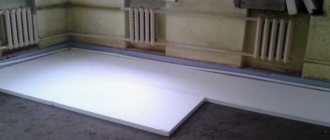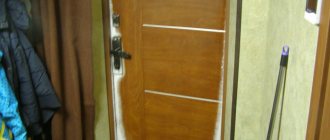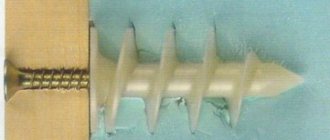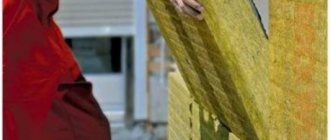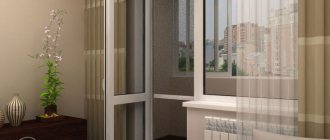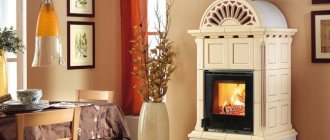Myth - Insulating a façade is expensive
If you decide that it is absolutely necessary to insulate the facade and there is no return to your decision, the time will come to purchase materials. In order to cover the entire house, you will need relatively large amounts of money.
To reduce heating costs, many owners of houses and apartments are thinking about insulation. One of the possible options is insulating the facade with polystyrene foam (PPS or EPS). The work is not the easiest, but you can do it with your own hands. It is important to know the technology. We will talk about it in detail further.
Proper insulation of the facade with polystyrene foam will give good results
Final finishing of the facade
To apply a protective layer of plaster to the foam cladding, you must first install profiled corner strips at the corners of the building and secure a painting mesh to the surface. The protective layer of plaster is applied in strips 100-120 cm wide and carefully leveled on the finishing surface so that there are no seams or overlaps of the mesh. The plaster mass begins to be applied and leveled from the corners.
After an hour and a half, the laid plaster is rubbed down for finishing. This can be painting with acrylic paints, applying decorative plaster such as “bark beetle” or cladding the facade with wall panels imitating wood or natural stone.
EPS or EPS (foam plastic or extruded polystyrene foam)
Insulating a facade with polystyrene foam begins with deciding the question: what is better to use, polystyrene foam (PPS) or extruded polystyrene foam (EPS). Both materials are made from the same starting material (polystyrene), but they use different technologies. It is hardly worth going into the intricacies of the processes; it is important to know the main differences between these two materials. So, in short:
- Polystyrene foam is softer, absorbs moisture, and insects and rodents like to nest in it. With good characteristics, it has a low cost.
- EPS is harder and denser, practically does not absorb water, insects and rodents do not like it. Its main disadvantage is its high price. In the case of insulating walls from the outside, there is another disadvantage - it requires pre-treatment (you have to scratch the surface), and this takes time.
There is another advantage of EPS - usually the slabs are made with a quarter, that is, there will be much fewer direct joints during insulation, which means there will be fewer cold bridges. The choice is not easy, especially considering that the price difference is significant - 2 times. To make it easier to decide, several positions at EPP and PPP prices are shown in the table.
Prices for foam plastic
Having decided on the type of material, you can begin installation.
Types and brands
In addition to the usual polystyrene foam type EPS, there is also an extruded variation , designated as EPS.
It is obtained in a similar way, but is mixed in an extruder , followed by pressing and foaming through the head.
Thanks to this processing, it turns out to be more rigid and resistant to mechanical damage at a similar density (from 10 to 35 kilograms per cubic meter), however it is somewhat more expensive.
Experts recommend using this insulation on the walls of apartment buildings in regions with strong winds. In other cases, traditional façade PPS is sufficient.
Extruded foam is rarely used as insulation, but its advantage is strength. But due to the high styrene residue, it is considered toxic and unsafe in terms of fire.
Visually, it is distinguished by the absence of foam balls, like PPS. It is produced in slabs with a density of 10 to 20 kilograms per cubic meter, but it has a high moisture absorption coefficient .
Main brands produced:
- PSB-15. Its thermal conductivity is only 0.043 W/m. A cubic meter of this weighs up to 15 kilograms. Suitable for internal sound insulation and for installation in balcony structures. Thickness according to GOST – 10, 20 and 50 millimeters.
- PSB-25. Thermal conductivity at the level of 0.041 W/m. Density – from 15.1 to 25 kg/m3. The best option for insulating one-story houses and non-residential premises. Thickness according to GOST – 20, 30, 40, 50 millimeters.
- PSB-35. Thermal conductivity – 0.039 W/m. Density – from 25 to 35 kg/m3. It is used to insulate the first floor of multi-storey buildings, the basement, and floors (combined with underfloor heating). Thickness – 50 and 100 millimeters.
You may be interested in learning about modern materials for insulating the exterior walls of a house. Read in this article.
The higher the density, the better the thermal insulation and rigidity of the finished structure. But at the same time, a large load is created on the load-bearing wall or facade. And you need to take into account that only standardized sizes of insulation slabs are indicated.
Manufacturers undertake the production of thermal insulation of any size .
That is, it is quite possible to order polystyrene foam type PSB-10 with a thickness of 5 millimeters.
Preparatory work
Insulating the facade with foam plastic begins with preparing the walls. Let's immediately say when it is better to start work - in the warm period of time. But the most important indicator is the humidity of the walls. They must be dry. After the rain, it is advisable to wait a week for dry, preferably windy, weather. After that you can start.
Preparation of external walls
Preparation for insulating the facade with polystyrene foam begins with cleaning everything that flakes and falls off. If the walls were covered with paint, it is removed, the lime is cleaned off. If there are swollen areas of plaster or tiles, they will be resurfaced. Only what holds tightly should remain.
You need to clean everything that can fall
Then it’s time to level the walls. It is very good if the insulation boards lie on the wall with their entire surface, without voids. But such walls are the exception rather than the rule, therefore unevenness of about 1 cm per square meter is acceptable. Protrusions and holes that are large in depth/height must be leveled - filled with plaster mortar (pre-primed) or cut off. The smoother the surface, the easier the work will be.
To prime or not
There is no need to prime only those walls; running your hand over them will leave your palm clean. If there are white marks, pieces of plaster, sand, etc., it is better to prime it. This will ensure better contact of the glue with the wall. The operation takes little time, is simple, requires little money, and has great benefits. So if you are doing the insulation of the facade with foam plastic or EPS “for yourself”, it is better to prime it.
Priming is a simple process, but very useful.
Any primer is suitable for facade work. Normal companies are Ceresit, Master, Stolit, Kreisel, Tokan, Ekomix. The primer is diluted or not, depending on the release form and instructions, applied with a brush or spray. Spraying is faster and easier, but using a brush is better.
Preparation of EPPS
If you decide to insulate the walls outside with expanded polystyrene (EPS), its surface must be made not so smooth. Polystyrene foam has a looser structure and does not require preliminary preparation. You need to make scratches on the surface of the EPS, otherwise it will fall off from the glue.
Tools for preparing EPS
Take a spiked roller, which is used to process drywall, and roll it well in all directions. The second way is to take a brush with metal bristles and make grooves with it. Softer methods don't work. The work is not hard, but it takes a lot of time. This must be done before you begin installing polystyrene foam on the walls. If the insulation is laid in two layers, it is necessary to process the sheets for both layers.
Finishing window sills, slopes, ebb
It is better to install all elements - window sills, slopes and ebb (drip) before installing the insulation on the walls. When installing, you need to remember that you will still have a significant thickness of insulation + finishing. If window sills and slopes have already been installed, they will have to be replaced - they will be too short. In order for everything to look organic and fit easily into the insulating pie, the elements must have the following dimensions:
- The window sill should protrude beyond the plane of the wall by 3-4 cm (more or less is not necessary). If the insulation thickness is 60mm, you will need a window sill 100-110mm deep (60mm insulation, 10mm finish, 30-40mm overhang). When installing a window sill, all voids must be filled. You can lay thermal insulation plates, fill the gaps with polyurethane foam and lay a window sill on top of it all, load it with something heavy and leave it for 3-4 hours. Insulation of the facade with polystyrene foam begins with the slopes
- When separating the slopes, they should protrude beyond the plane of the existing wall (without insulation) by 1 cm. This will make it easier to connect it with the insulation. They sit it on glue (the same one that will be used when insulating the facade with foam plastic). There is another subtlety here: finishing the slopes requires insulation of a smaller thickness - 20-30 mm maximum. The thicker one will simply “climb” onto the glass (don’t forget about the presence of finishing layers, leave about 10 mm on them).
- Between the base and the insulation, a drip line is installed (also called a “drip cap”). This is a strip of galvanized steel with powder paint. It is mounted on the base with self-tapping screws or dowels (depending on the material of the base) in increments of 20 cm. Sold in pieces of two meters, during installation one piece overlaps the other by 10-15 cm. The ebb is necessary so that water flowing down the wall does not flow into the house, and merged into the street.
Installation of ebb (drip)
As you can see, the preparatory work before insulating the facade with foam plastic (polystyrene) also takes time. They are not complicated, but have a significant impact on the overall result.
Sequence of installation of external insulation
Important. The primer for finishing with polystyrene foam must be designed specifically for the material from which the building is constructed. Acrylic-based primer mixtures for concrete plastered surfaces, for example, not only increase the adhesion of materials and ensure the strength of the finish, but also protect the walls from the occurrence of fungal and mold processes under the cladding.
- Fastening sheets of foam plastic to the prepared surface using special adhesive mixtures for polystyrene foam boards.
When finishing the facade of a private house with polystyrene foam is carried out independently, many make the following common mistake - they purchase a more expensive adhesive composition, deciding that the higher price is due to the quality and composition of the adhesive mixture. This is not entirely true.
Different adhesive compositions are designed for use in different climatic conditions. For example, in areas where winter temperatures do not exceed twenty degrees below zero, it is not at all necessary to use an adhesive composition that has high frost resistance. And increased frost resistance naturally increases the cost of polystyrene foam glue.
Advice: Carefully study the composition of the adhesive mixture, as well as its technical characteristics. More expensive is not a synonym for better.
- Additionally, the insulation sheets are fixed to the wall using self-tapping screws;
Important. Attaching foam sheets must be done from the bottom up. In order for the material to be installed level, it is first necessary to secure a guide bar parallel to the wall.
- After the lined surface has dried (on average three days), the joints between the plates are grouted; large gaps can be filled with polyurethane foam;
Advice. In some cases, during work on the exterior decoration of houses, it is necessary to achieve a more dense shrinkage of the adhesive mixture. Craftsmen advise adding a soap solution or ordinary detergent to the adhesive mixture, which gives the composition elasticity and ensures good shrinkage.
Reinforcing mesh
- Finishing facades with foam plastic also involves installing a reinforcing layer on top of the insulation. The mesh should be pressed tightly against the insulated wall and fixed at the edges. Reinforcement protects the insulation from impacts and gives strength to the finish;
- After the reinforcing layer has dried, the walls are finished with plaster.
The finishing of insulated walls can be very varied.
Advice. The formation of “cold bridges” should not be allowed when externally insulating the façade. Such problem areas most often arise in places where cornices are attached, insulation is connected to window and door frames, as well as in places where utilities are installed. It is important to carefully treat with polyurethane foam and insulate the junctions of metal structures with insulation.
Technology for installing foam plastic on walls
For a normal result, foam plastic is first glued to the walls, then nailed. Exactly this way and no other way. Gluing begins from the bottom, usually from the left corner. If a house is insulated with polystyrene foam, then the first row is supported by the installed flashing; if the thermal insulation of an apartment building is improved, a starting strip is nailed down. Without it, there is a high probability that the foam will creep down.
Materials and tools
To stick polystyrene foam on the walls, you will need two spatulas. One is about 100 mm wide, the second is 180-200 mm. The narrow one is used to pick up glue from the container, and the wide one is used to apply it to the walls. You may also need a saw with a fine-tooth blade to trim the material. That's all of the tools at this stage. You will also need glue. It requires a special one; the bag should say “for polystyrene boards” or something similar. There are two types of this glue:
- A universal composition for polystyrene and subsequent façade finishing (gluing mesh and leveling layer).
- The composition is only for gluing polystyrene to walls. Other layers require a universal one.
If we approach the issue from an economic point of view, it is more profitable to buy two different compositions - the universal one is significantly more expensive. And with glue you can do a number of operations:
- glue polystyrene to the wall and slopes;
- coat the joints of the insulation;
- lubricate the fastening mushrooms;
To glue polystyrene to walls you need special glue
The list of works for which universal glue is required is as follows:
- gluing mesh to corners (and slopes too) and walls;
- applying a leveling layer.
The consumption of both compositions is approximately the same and amounts to 4-6 kg per square meter. The consumption may be less if the walls are initially flat and a smaller layer of glue is required (no need to level the depressions). The consumption for the leveling layer (after gluing the mesh) depends on how smoothly the polystyrene is fixed, whether its corners stick out or not.
For additional fixation of polystyrene to the wall, fungi are needed
For the second stage - fixing the polystyrene to the walls - you will need fungi. These are specially shaped dowels with a large plastic cap and a long stem. Steel or plastic dowel-nails are inserted into the dowels. When insulating a facade with polystyrene, it is better to use plastic ones. They do not conduct cold, are not subject to corrosion, cost less, and a large insulated façade does not create loads.
To install the mushrooms you will need a drill and a hammer. To apply the mesh and leveling layer, you will need an even wider spatula - 300-350 mm or even more. To sand the leveling layer, you will need a plastic grater and sandpaper with a grain of 400-500.
Technique for gluing polystyrene to walls
The glue is mixed with water according to the manufacturer’s recommendations (stir with a drill with an attachment or a mixer). It is more convenient to work when it is a little thicker than it turns out if you follow the recommendations. Therefore, we add a little less water, and then see how convenient it is to work.
If the wall is uneven, apply glue to the wall. This makes it easier to correct unevenness - put more in the recesses and less on the humps. If there is too much of a hump left, a recess can be made in the foam to reduce glue consumption. This trick will not work with EPPS.
Apply glue something like this, but only on the walls, not on the foam.
Lay the mortar in “cakes” up to 9-10 in area, and also make a roller (not continuous) approximately along the perimeter of the slab, retreating 3-4 cm from the edge. The sizes of the tortillas are not necessarily the same. It is only important to level the surface as much as possible. Having laid out the glue, apply polystyrene foam, press it down, and clap it with your palm (not too hard so as not to crush it). Sausages placed along the edges may come out of the seams or “swim” under other sheets. The fact that they crawl onto other sheets is normal and even good, it will hold on more firmly. But it’s better to pick up the glue that has come out. Then there will be less leveling.
There is a second technique - apply glue to the foam, level it with a comb (notched trowel) and glue it like that. But this method is only suitable for smooth facades without differences.
If the wall is smooth, apply a continuous, even layer on the foam.
When laying the second row, the sheets are placed so that the seams are not continuous (offset, such as brickwork). We also make sure that all subsequent rows do not match. Leave the foam glued to the façade for 3 days—that’s about how long it takes for the glue to dry. In the meantime, we glue it on the second section.
A few words about how it is more convenient to glue foam plastic to the facade and what kind of area it is. If a private house is insulated with polystyrene foam, the work area is significant, as is the height. Some of the work can be done from the ground, while some will have to be done from scaffolding. To carry them around less, it is more convenient to carry out work in sections. One section is completed completely - from gluing the foam to the leveling layer, then move on to the next. This order of work has another advantage: less polystyrene remains open (it reacts poorly to ultraviolet light).
The house is divided into sections with different stages of work
We nail polystyrene foam (EPS)
So, after the glue has dried (3 days have passed since it was glued), we take plastic mushrooms (the more expensive ones are hard and clog well). Their length depends on the thickness of the insulation. To it (thickness) you need to add 4-5 cm, by which the fungus should enter the wall. If you have polystyrene with a layer of 50 mm, then the fungi should be no shorter than 9-10 cm.
Fungi should extend 4-5 cm into the wall. There is an inaccuracy in the figure - the mesh is glued on top of the fungus
One slab requires 5-6 mushrooms. In selected places, holes are drilled (10 mm drill) 2-3 cm deeper than the length of the fungus stalk. If you make the holes shorter, they become clogged with material dust and are not inserted completely. The location of the fungi is one in the center of the slab and several at the joints. This position allows you to nail the foam and level the wall at the same time (pull the coal into the desired position).
Scheme of the location of fungi when insulating a facade with foam plastic
A fungus is inserted into the drilled hole and then driven in with a hammer. Its cap should lie tightly on the insulation. If it doesn’t lie, take it out and deepen the hole. Sometimes after a certain number of installed fungi they stop clogging. This means that the drill has become worn down - it has become smaller in diameter - and it’s time to change it.
We hammer plastic dowels into the fungi
The fungi are hammered in so that the cap is slightly recessed in the foam - it goes away by about 1 mm. Then the glue consumption for the leveling layer will be less. It’s easy to hammer in with polystyrene foam, but more difficult with expanded polystyrene (EPS).
If there are two layers of insulation
If the required insulation thickness is more than 50 mm, but less than 100 mm, two layers are laid. In this case, one layer is glued, as described above, the sheets of the second are positioned so that they do not coincide with the joints of the first. When gluing the second layer, it is more convenient to apply the glue to the sheet rather than to the wall. The joints of the first one do not need to be rubbed or foamed - they will overlap.
If you have time, it is advisable to wait until the first one dries before applying the second coat. If this is not possible, you can glue a second one at once, but to a height of no more than 2 m, otherwise the sheets may move.
The seams of the first and second layers should not match
We begin nailing the foam with fungi after the glue has dried (the same 3 days). Just don’t make a mistake when calculating the length of the fungus - the total thickness of the insulation + 1 cm for glue + 4-5 cm for the wall. The depth of the hole is another 2-3 cm larger, the diameter is the same 10 mm. When the foam is nailed to the facade, you can move on.
Sealing joints and fungi
First, we level the area of the facade covered with foam plastic. It often turns out that the edges of the foam stick out somewhere. They can be cut with a stationery (wallpaper) knife. There are also special graters for foam plastic. They are convenient for leveling the surface. You can also try to do this with EPS, but only with a knife, and it doesn’t cut well. The work takes a lot of time, but it’s worth spending time on it - it will greatly reduce the consumption of expensive compounds for subsequent layers of finishing.
Then, to prevent cold air from getting between the slabs, the seams are rubbed. Using a spatula, use the same compound that was used to glue the foam onto the façade and fill the seams. If there are seams larger than 3 mm, we put a narrow strip of insulation in them, then seal them with glue. You can fill the seam with foam. We leave it for 4-5 hours, then cut off the excess with a knife and rub it with glue on top. The caps of the fungi are recessed; we cover them too, leveling them with the main surface.
Rubbed foam seams
When grouting seams and caps, we try to make the surface smooth - the glue should not protrude. If you looked somewhere, after drying, take a grater, attach sandpaper (400-500 grain) and level it. You just need to wait for it to dry completely - once it gets into wet glue, the sandpaper instantly becomes clogged, you just need to change it (the mesh is not suitable for this work).
Preparation for finishing and insulation of the facade
Foam boards tolerate frontal load very poorly. This means that even a small force applied perpendicular to the plane of the slab can lead to cracking or chipping of the insulation on the facade. Therefore, before laying polystyrene foam, the walls of the house must be leveled for a long time and carefully, achieving maximum adherence of the finishing material to the plane of the building facade. Forget about permissible protrusions and bumps with a height difference of up to 1 cm. The wall must be cleaned of paint, old finishes, and anything that could cause the foam board to not adhere tightly to the surface of the facade.
After cleaning the walls, it is necessary to prime the surface with an antifungal compound. Polystyrene foam practically does not allow water vapor to pass through, so acceptable living conditions for fungus and pathogenic microflora can be created under foam plastic boards. If the walls are made of concrete, the second layer is priming the GGP according to the type of concrete contact.
The next step is to install a starting strip along the perimeter of the walls, at a height of 4-5 cm from the blind area of the building’s foundation. The width of the starting rail is selected according to the thickness of the slab. The slats are carefully leveled horizontally and attached to the walls of the facade on sliding hinges.
Reinforcement and plastering of foam plastic
Sometimes the insulation of a facade with polystyrene foam needs to be extended over two seasons - left to overwinter at some stage. Without harm to materials, it can be left only after applying a leveling layer. Simply attached polystyrene foam (EPS) cannot be left. It is recommended to keep it even packed in packs indoors and not outside. So you can only stop after plastering.
Sticker of reinforcing mesh on corners
The mesh is used as a façade mesh for exterior work (the inner mesh will simply crumble from the glue). Density 140-160 g/sq. m. First, glue the corners. All corners are reinforced - both external and internal, and slopes. Important! From now on, you need to use a universal composition, and not the one on which the foam was glued. The glue is diluted a little thinner than indicated in the instructions - it should stick well to the spatula, but be easily pressed through the mesh.
For reinforcement, you can use a ready-made corner with a mesh, you can cut strips from a roll (30 cm wide) and glue them. It’s easier to work with a ready-made corner, cheaper - with a piece of mesh. If you make it from a roll, cut strips across the roll, you get pieces a meter long. Fold them in half lengthwise and press the fold well with a spatula. You need to fold it so that the edges of the mesh are wrapped inward (it was in a roll). If it turns out the other way around, they will stick out from the layer of glue and it will be difficult to work.
Corner reinforcement mesh
Either way the work is almost the same. A strip of mortar 6-7 cm wide and 2-3 mm thick is applied to the corner on both sides. If you are gluing not a finished corner, but bent strips of mesh, then the length of the area filled with mortar should be 5-7 cm shorter than the cut piece (93-95 cm).
A corner or piece of bent mesh is placed on top. Running a spatula over the mesh, lightly press it into the glue. Herringbone movements - from top to bottom and to the side.
About half of the mesh on the sides remains without glue. This is normal - it will be easier to join it with foam reinforcement in the plane of the wall. Also, without glue, a strip remains at the top if you glue from pieces. When gluing the next piece above, apply glue directly to this “empty” mesh and cover it with the next piece on top. This way the joint is the same thickness as the entire corner.
When forming an angle, we try to make it even. If you can’t do it with a regular spatula, you can use a corner one (pictured above). It won't be difficult - just move from top to bottom with one click.
Foam reinforcement on walls
Polystyrene foam and EPS are reinforced by applying a layer of plastic mesh, which is pressed into the adhesive composition (universal). The procedure is as follows:
- Apply a layer of glue (universal composition) to the wall with a spatula (width at least 350 mm). The width of the strip is 5-7 cm narrower than the mesh (the mesh is usually 100 cm wide).
- Roll out the mesh from top to bottom, so that 5-7 cm from one edge are free of glue.
- Pass the spatula over the mesh, pressing it into the glue. They try to make the surface smooth. The mesh is rolled out onto the laid layer of glue and pressed into it with a spatula.
- The second strip of glue is applied, starting from the section of the “empty” mesh. A new piece of reinforcement is applied close to the one already laid. It turns out there are two layers of stack at the junction, but the thickness of the glue is the same as on the rest of the wall. It can be seen that part of the mesh remains without solution
The glued mesh is left to dry. It should take at least half a day, or better yet, a day. Then take a grater with sandpaper and smooth out all the unevenness.
Preparing the foam
Covering the walls with foam plastic on the outside requires the preparation of insulation. This stage refers to extruded polystyrene foam, which is called penoplex. The technology differs from the sequence for foam plastic only in that in this case you have to deal with a smooth surface that needs to be made rough. The sheets must be pierced with a needle roller. Sometimes a notch is made on them using a stationery knife.
